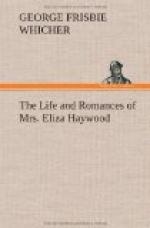supernatural, the author deliberately avoided any
occasion for talking gossip or for indulging “persons
of airy tempers” with sentimental love-tales.
“Instead of making them a bill of fare out of
patchwork romances and polluting scandal,” reads
the preface signed by Duncan Campbell, “the
good old gentleman who wrote the adventures of my
life has made it his business to treat them with a
great variety of entertaining passages which always
terminate in morals that tend to the edification of
all readers, of whatsoever sex, age, or profession.”
Those who came to consult the seer on affairs of the
heart, therefore, received only the scantiest mention
from his biographer, and never were the languishing
and sighing of Mr. Campbell’s devotees described
with any romantic glamor. On the contrary, Defoe
portrayed in terse and homely phrases the follies
and affectations of the dumb man’s fair clients.
The young blooming beauty who found little Duncan “wallowing
in the dust” and bribed him with a sugarplum
to reveal the name of her future husband; the “sempstress
with an itching desire for a parson”; housekeepers
in search of stolen goods; the “widow who bounced”
from one end of the room to the other and finally
“scuttled too airily downstairs for a woman
in her clothes”; and the chambermaid disguised
as a fine lady, who by “the toss of her head,
the jut of the bum, the sidelong leer of the eye”
proclaimed her real condition—these types
are treated by Defoe in a blunt realistic manner entirely
foreign to Eliza Haywood’s vein. Some passages,[2]
perhaps, by a sentiment too exalted or by a description
in romantic style suggest the hand of another writer,
possibly Mrs. Haywood, but more probably William Bond,
in whose name the reprint of 1728 was issued.[3] But
in the main, the book reflected Defoe’s strong
tendency to speculate upon unusual and supernatural
phenomena, and utterly failed to “divulge the
secret intrigues and amours of one part of the sex,
to give the other part room to make favorite scandal
the subject of their discourse."[4]
That Defoe had refrained from treating one important aspect of Duncan Campbell’s activities he was well aware. “If I was to tell his adventures with regard, for instance, to women that came to consult him, I might, perhaps, have not only written the stories of eleven thousand virgins that died maids, but have had the relations to give of as many married women and widows, and the work would have been endless."[5] In his biography of the Scotch prophet he does not propose to clog the reader with any adventures save the most remarkable and those in various ways mysterious.




